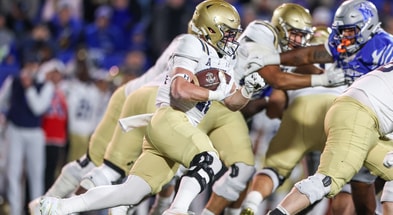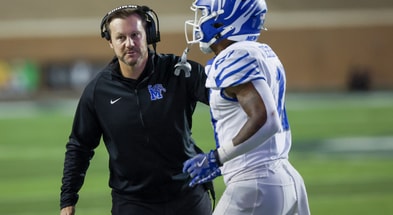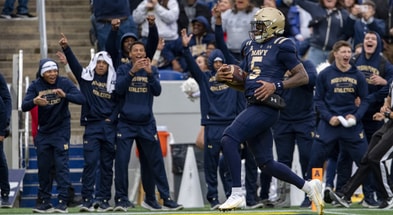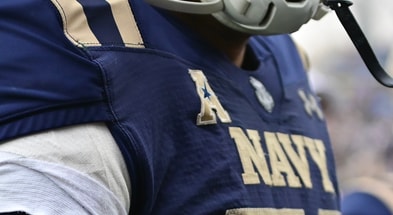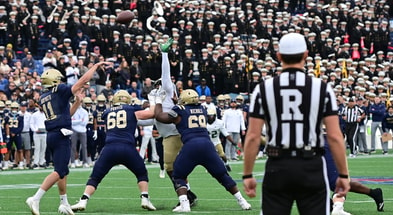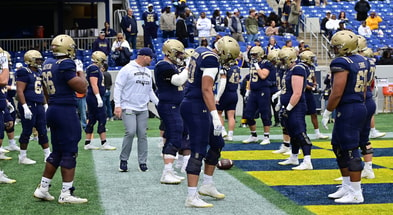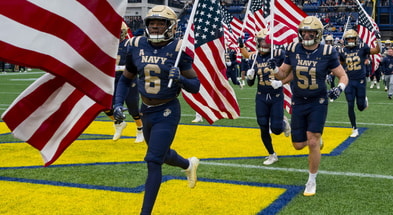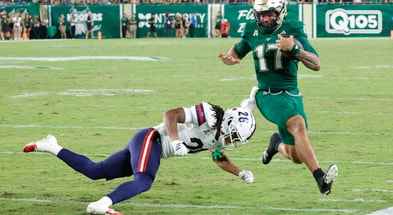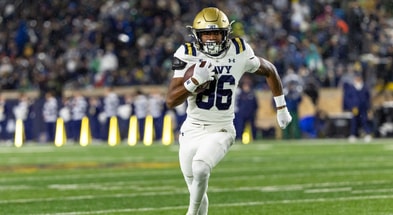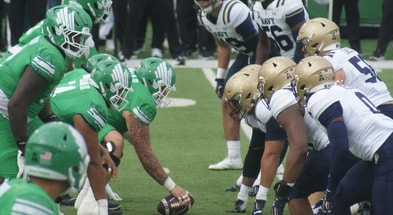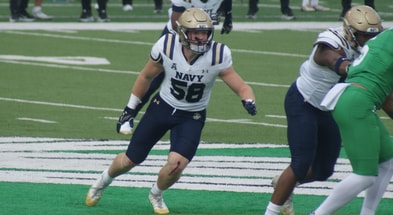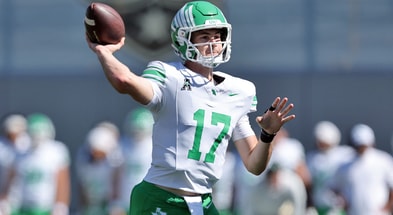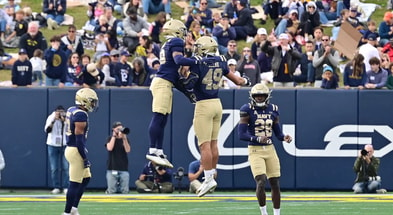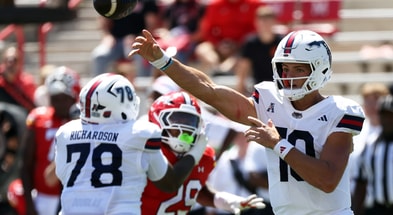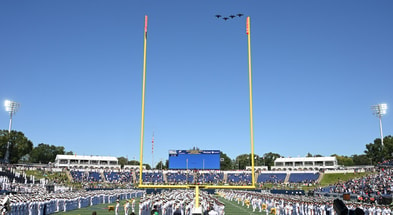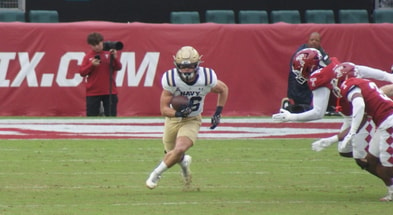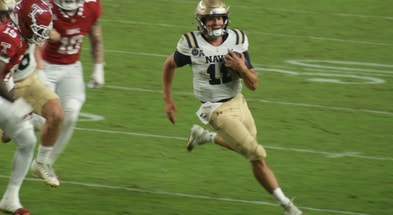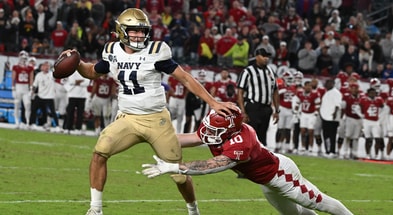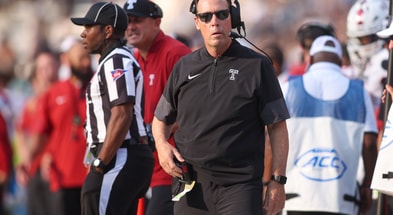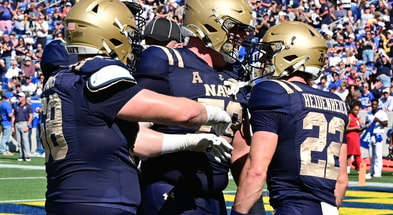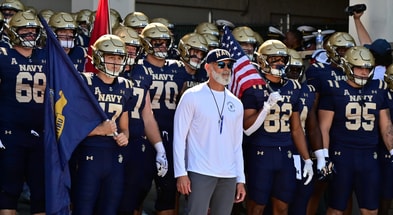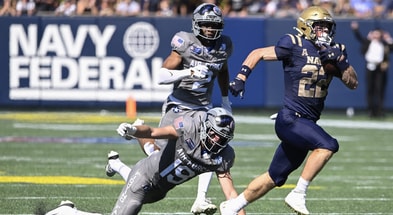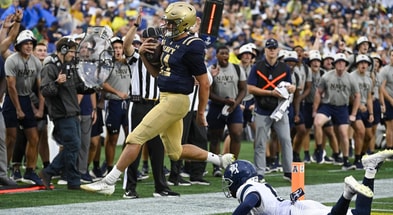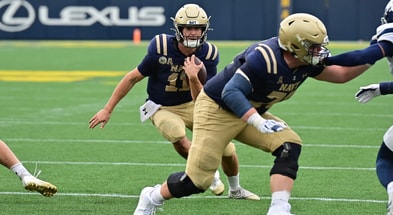The Temple Debrief
“You know, he’s not maybe that guy who’s going to shake you and take it for 80, but boy, he’s athletic and he throws the ball really well.”
Temple head coach K.C. Keeler said this about Blake Horvath in his press conference last week. And he was right: Horvath did not have any 80-yard runs in the game. He did, however, have a 51-yard touchdown run with 39 seconds left to play. Then, on the ensuing two-point conversion, he fought off the defender at his legs to find Alex Tecza in the end zone to give Navy the lead, and ultimately, a 32-31 win.
What a game.
I think it’s fair to have both a glass-half-full and a glass-half-empty reaction to what we saw. For the former, one might point out that a senior-laden offense did exactly what it was supposed to do: stay calm under pressure and find a way to win. Horvath to Tecza on the two-point conversion had big Montana to Clark vibes. You’ll take conference wins on the road, however you can get them.
But the pessimist would point out that Navy got lucky. They shouldn’t have even had a chance to come back to win; Keeler’s decision to score immediately rather than milk the clock on their last touchdown gave the offense 1:16 and two timeouts for their final drive. Meanwhile, the defense gave up over 500 yards and 11.2 yards per third-down play. They’ve played with fire a couple of times this season, and this was the closest they’ve come to getting burned.
Both sides have a point. While the offense showed its poise and resiliency, the defense showed vulnerabilities that will likely be the target of every future opponent’s game plan.
So let’s start with the defense, then. On that side of the ball, I think we can divide up the game into two categories: what Navy did wrong, and what Temple did right. And there was plenty of the latter. I thought Temple offensive coordinator Tyler Walker had a tremendous game plan that took advantage of the game situation, as well as some of Navy’s tendencies.
Here’s an inside zone run where Navy appeared to do everything right. Temple double-teamed Landon Robinson, but Robinson was such a handful that the center wasn’t able to move on to the second level. Job Grant stepped into his assigned gap. When the running back saw this, he bounced outside. But the striker is in conflict here. He can’t be aggressive against the run because he has to cover the receiver who faked a bubble screen. That holds him outside and gives the RB room to run outside.
Later in that drive, Temple used a similar approach in the passing game. Here, a fake jet sweep keeps the linebacker from getting too much depth in his zone. Both safeties cover the tight end, which leaves room for a pop pass to the RB coming out of the backfield.
At the end of the first half, Temple used the levels concept to create room for the tight end. Levels floods the middle of the field with in-breaking routes at different depths, forcing linebackers and safeties to choose which one to cover. In a two-minute situation, the safeties are going to be focused on preventing the deep ball. The underneath routes kept the linebackers from getting depth in their zones, opening room for the deeper route by the tight end.
Navy only rushed three on that play. A couple of plays later, they rushed five. The quarterback did what you’re supposed to do in that situation, which is throw into the blitz. The receiver got just enough inside leverage on the cornerback to get a step on him, and the throw was perfect.
This is all great stuff from Temple. But a lot of their success can also be attributed to things Navy did poorly.
It started on their first drive. On this play, both the safety and corner covered the flat. One of them was supposed to play the deep zone. Someone missed an assignment.
This next play is a wide receiver screen. The center is out on the perimeter in front of the receiver. The safety reads the play and is in a good position. But instead of taking on the block of the center– and I acknowledge that meeting a center barreling downhill is nobody’s idea of fun– he sidesteps the block.
If he took on the center there, he would have forced the ball carrier to go to either the left or right, where defenders were waiting on both sides. Instead, the safety basically threw a block on his own guy while the receiver didn’t have to alter his path.
One of the frustrations that P.J. Volker expressed in his Zoom call this week is that many of these plays are just about knowing the basics. There were similar problems with run defense. Here is an RPO that Temple ran in the first quarter. It seems like Navy should have this bottled up: a defensive lineman catches the running back, and the striker put himself in a position between the quarterback and the “pitch.” However, the B gap remains uncovered. The linebacker plays the A gap, while the nose guard loops around to the C gap.
Guess where the quarterback runs.
Brian Newberry mentioned in his Zoom call that Navy did a poor job of handling Temple’s motion. Here’s an example. Before the receiver goes in motion, it looks like a safety is responsible for the C gap. Once the receiver goes in motion, one safety hands off responsibility to the other. But when that happens, nobody covers the C gap anymore. There are three defenders on the perimeter, but none in the C gap.
Guess where the running back goes.
One factor in these miscues may have been that Navy was often late getting the play in. This was a surprise to me; Temple used a little bit of tempo, but they’re one of the more deliberate teams in college football when it comes to pace of play. Getting the play in late leaves less time for the defense to talk to each other and get on the same page. Volker took responsibility for this in his media call, saying that it would be better to call a good play early, rather than taking too much time coming up with a perfect play. But that wouldn’t fix the poor tackling, which was another glaring issue.
Even as good as Temple’s game plan was, if Navy was more fundamentally sound defensively, we’d probably be discussing a 10-point Navy win instead of a nail-biter. That’s a big if, though. It’s a good time for a bye week, because the defense has a lot to work on.
Offensively, Navy’s biggest problem was a lack of opportunities. In the first half, Temple ran 50 plays while the Mids were limited to only 17. They only needed four plays to score on their opening drive, but none of their other possessions in the first half lasted longer than four plays, either. The Mids hurt themselves with a false start penalty and a fumble that both put them behind the chains. In the second half, though, Navy had 273 yards of offense and scored on every drive.
Things couldn’t have started much better. On the first play here, they overloaded the play side on this triple option. Cody Howard, after shifting, got outside leverage on the playside ILB. The backside safety played the fullback first, then, after reading the play, followed the pitch outside.
That set up the touchdown pass. With the safeties playing man, Drew Cronic sent backfield receivers in opposite directions. That pulled the safeties in opposite directions, leaving the middle of the field wide open. Howard faked another block on the ILB, then took off. The backside cornerback was fooled by the fake and stopped covering Howard. There was nobody in the same zip code when he caught the ball.
After a start-and-stop first thirty minutes, Navy settled into its offense more in the second half. Defensively, Temple didn’t use any stunts or gimmicks. As the Mids ran their plays, it became apparent that what the Owls were doing was keying on the running back, which was usually Alex Tecza. Even if Tecza didn’t get the ball, they seemed to figure that he’d be blocking for whoever was.
The Mids did a few things in response, including running RPOs. On the first one, running Tecza inside drew in the linebackers and kept them from following the play outside. Brandon Chatman was covered by a safety who had to come from the other side of the field.
On the second RPO, Tecza again drew the ILBs forward. This time, Chatman was covered by the playside cornerback. But Eli Heidenreich ran a crossing pattern from the other side of the field, and with the ILBs coming forward to play the RB, he was wide open.
However, the most common tactic the offense employed was the use of misdirection. They’d send Tecza or Jackson Gutierrez one way, then run the ball behind the linebackers who followed.
You can’t just run misdirection all the time, though, because the defense will eventually figure out what’s going on. Navy had to give the linebackers a reason to keep keying on the RB. The Mids did this in a few ways. First, they just ran as fast as they could to outflank the defense. Here are a pair of option plays with Tecza as a lead blocker, with the Mids able to turn the corner.
They also ran the ball with the RB. Here is a triple option play. Cody Howard is lined up in the “slotback” spot. Normally, the playside slotback would load from the linebacker to the safety, getting outside leverage on both. With the ILBs keying on the RB, though, Howard released inside the tackle and acted as a lead blocker for the dive.
The offense also used the counter option. The action of the QB and Tecza’s initial path causes the ILBs to run to the wrong gap.
Eventually, the linebackers did catch on. On the first play here, you can see the playside ILB running outside to the ball while Tecza ran inside. After that happened, the Mids went back to using him as a lead blocker.
Toward the end of the game, Temple started to key on Howard. Here are two plays. The first is the failed pass attempt by Gutierrez. It’s actually a kind of RPO; Horvath probably should have kept the ball. But when Howard shifted, an inside linebacker shifted to match. He was unaccounted for, and the play was stopped for a loss.
On Horvath’s game-winning touchdown, the Mids lined up in a similar formation, but with a slot receiver instead of a second back in the backfield. Temple shifted like they did on the last play. But this time, they were exposed up the middle. The playside safety lined up over the receivers. There was also a late stem by the defensive line that left Howard uncovered. That gave him a free path to the other safety. As long as Ben Purvis blocked the playside ILB when he pulled, there would be nobody left in front of Horvath.
Temple actually defended the ensuing two-point conversion well. The receiver runs inside to block for the rollout, hopefully taking the cornerback with him. But Temple sent an outside linebacker into the backfield on the snap, and the corner recognized what was happening and peeled off his coverage of the receiver. This led to the play getting strung out. Horvath had to wait until the last possible second for Tecza to get open, but when it happened, he threw a strike.
And with that, the Mids pulled off some magic.
There are still a lot of questions about this team, especially on defense. But for now, I hope Navy fans enjoyed this game for what it was. College football is an emotional game, and few things stir the emotions quite like a furious comeback with exceptional plays at the end. Winning is hard, and even the best teams can point to one or two games they won when maybe they shouldn’t have. It’s always better to address issues after a win.
